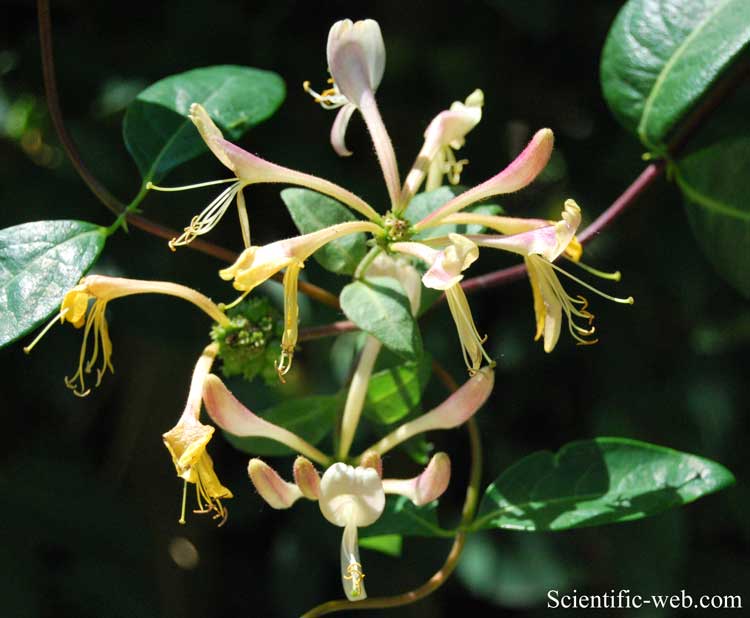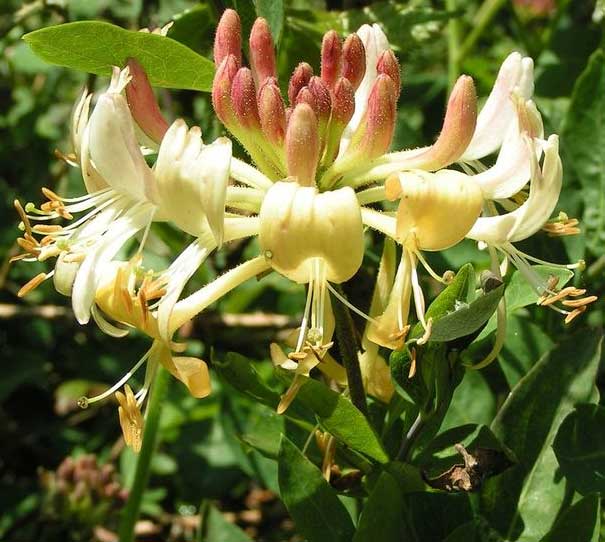
Lonicera periclymenum, Photo: Michael Lahanas
Classification System: APG IV
Superregnum: Eukaryota
Regnum: Plantae
Cladus: Angiosperms
Cladus: Eudicots
Cladus: Core eudicots
Cladus: Asterids
Cladus: Campanulids
Ordo: Dipsacales
Familia: Caprifoliaceae
Subfamilia: Caprifolioideae
Genus: Lonicera
Subgenus: L. subg. Lonicera
Sectio: L. sect. Lonicera
Subsectio: L. subsect. Lonicera
Species: Lonicera periclymenum
Subspecies: L. p. subsp. hispanicum – L. p. subsp. periclymenum
Name
Lonicera periclymenum L., Sp. Pl. 1: 173 (1753).
Homonyms
Lonicera periclymenum Gouan = Lonicera etrusca G.Santi
Lonicera periclymenum Lour. = Lonicera confusa (Sweet) DC.

Lonicera periclymenum (*)
References
Linnaeus, C. 1753. Species Plantarum. Tomus I: 173. Reference page.
Links
Hassler, M. 2019. Lonicera periclymenum. World Plants: Synonymic Checklists of the Vascular Plants of the World In: Roskovh, Y., Abucay, L., Orrell, T., Nicolson, D., Bailly, N., Kirk, P., Bourgoin, T., DeWalt, R.E., Decock, W., De Wever, A., Nieukerken, E. van, Zarucchi, J. & Penev, L., eds. 2019. Species 2000 & ITIS Catalogue of Life. Published online. Accessed: 2019 Aug. 18. Reference page.
Govaerts, R. et al. 2019. Lonicera periclymenum in Kew Science Plants of the World online. The Board of Trustees of the Royal Botanic Gardens, Kew. Published online. Accessed: 2019 Aug. 18. Reference page.
International Plant Names Index. 2019. Lonicera periclymenum. Published online. Accessed: Aug. 18 2019.
Tropicos.org 2019. Lonicera periclymenum. Missouri Botanical Garden. Published online. Accessed: 18 Aug. 2019.
USDA, ARS, Germplasm Resources Information Network. Lonicera periclymenum in the Germplasm Resources Information Network (GRIN), U.S. Department of Agriculture Agricultural Research Service.
Vernacular names
العربية: عسلة أوروبية
беларуская: Бружмель павойны
català: Xuclamel comú
čeština: zimolez ovíjivý, zimolez německý, zimolez lesní
Cymraeg: gwyddfid
dansk: Almindelig Gedeblad, Vedvindel, Almindelig Kaprifolie, Vild Kaprifolie
Deutsch: Deutsches Geißblatt
English: common honeysuckle, European honeysuckle, woodbine, honeysuckle
Esperanto: Eŭropa lonicero
español: madreselva de los bosques, bidaqueira, chupamiel, descuernacabras, enredadera silvestre, escuernacabras, hierba enredadera, madre de selva, madreselva, madreselva vulgar, madresilva, mariselva, marisilva, matrisilva, periclimeno, samuso, sogüeña, sogüeñas, virginia
suomi: Ruotsinköynnöskuusama
français: chèvrefeuille des bois, chevrefeuille des bois
galego: Herba salgueira
hornjoserbsce: Lěsny kozylist
magyar: Búbos lonc
italiano: periclimeno
lietuvių: Vijoklinis sausmedis
Nederlands: wilde kamperfoelie
norsk nynorsk: Vivendel
norsk: Vivendel
polski: wiciokrzew pomorski, suchokrzew pomorski
português: madressilva, madressilva-das-boticas
русский: Жимолость вьющаяся
slovenčina: zemolez ovíjavý
shqip: lulekace
svenska: vildkaprifol, höstkaprifol, Vrevrång
Türkçe: hanimeli
Lonicera periclymenum, common names honeysuckle, common honeysuckle, European honeysuckle, or woodbine, is a species of flowering plant in the family Caprifoliaceae native to much of Europe, North Africa, Turkey and the Caucasus.[2] It is found as far north as southern Norway and Sweden.
Description
Growing to 7 m (23 ft) or more in height, it is a vigorous deciduous twining climber, occasionally keeping its old leaves over winter.[3] In the UK it is one of two native honeysuckles, the other being Lonicera xylosteum. It is often found in woodland or in hedgerows or scrubland.
The tubular, two-lipped flowers,[4] creamy white or yellowish in colour, may be flushed with pink or red on the outside and in bud, and are carried in showy clusters at the ends of the shoots.[2] The flowers are highly scented by night, much less so by day.
Ecology
The plant is usually pollinated by moths or long-tongued bees and develops bright red berries. Dormice make summer nests for their young from honeysuckle bark; they also eat the flowers, which are a good source of energy-rich nectar. Night-flying moths such as the hummingbird hawk-moth can detect the scent of honeysuckle flowers up to a quarter of a mile away. The clusters of red berries are eaten in the autumn by birds such as thrushes, bullfinches and warblers.[5]
Cultivation
Lonicera periclymenum is one of several honeysuckle species valued in the garden, for its ability to twine around other plants, or to cover unsightly walls or outbuildings; and for the intense fragrance of its profuse flowers in summer. It needs to be planted with its roots in the shade, and its flowering top in sun or light shade. Plants need to be chosen with care as they can grow to a substantial size.[4] The cultivars 'Graham Thomas'[6] and 'Serotina'[7] have gained the Royal Horticultural Society's Award of Garden Merit.[8]
Woodbine on a willow tree
Pests
Chromatomyia aprilina – honeysuckle leaf miner
Cultural references
In William Shakespeare’s play A Midsummer Night's Dream he refers to woodbine/honeysuckle twice:
(Act II Scene 1) "Quite overcanopied with luscious woodbine"
(Act IV Scene 1) "So doth the woodbine the sweet honeysuckle gently entwine"
It seems probable that the first quotation is referring to the honeysuckle L. periclymenum, a common sight in hedgerows in Shakespeare’s time. The second quotation is somewhat more confusing. It is thought that on this occasion, "woodbine" refers to a species of Convolvulus, also very common but nowadays called "bindweed".[9]
References
"The Plant List: A Working List of All Plant Species". Retrieved 7 December 2014.
RHS A-Z Encyclopedia of Garden Plants. United Kingdom: Dorling Kindersley. 1996. p. 631. ISBN 0751303038.
Flora Britannica. United Kingdom: Sinclair-Stevenson. 1996. p. 348. ISBN 1856193772.
RHS A-Z encyclopedia of garden plants. United Kingdom: Dorling Kindersley. 2008. p. 1136. ISBN 978-1405332965.
"The Woodland Trust: Explore Woods: Honeysuckle (Lonicera periclymenum)". Retrieved 12 October 2017.
"RHS Plant Selector - Lonicera periclymenum 'Graham Thomas'". Retrieved 29 October 2020.
"RHS Plant Selector - Lonicera periclymenum 'Serotina'". Retrieved 29 October 2020.
"AGM Plants - Ornamental" (PDF). Royal Horticultural Society. July 2017. p. 61. Retrieved 25 March 2018.
"Plants". Shakespeare’s words. Retrieved 26 March 2018.
Retrieved from "http://en.wikipedia.org/"
All text is available under the terms of the GNU Free Documentation License

